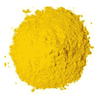
Tartrazine
Moderate risk
Alternate Names:
- acid yellow 23
- ci 19140
- ci food yellow 4
- ci food yellow 5
- fd&c yellow 5
Info from food-info.net:
- Description:
- Function:
- Yellow food colour. Very soluble in water.
- Origin:
- Synthetic azo dye. See here for a background on azo dyes.
- Side effects:
- Tartrazine is an azo dye. No side effects are known for pure tartrazine, except in people who are intolerant to salicylates (aspirin, berries, fruits); in that case tartrazine also induces intolerance symptoms. In combination with benzoates (E210-215), tartrazine is implicated in a large percentage of cases of ADHD syndrome (hyperactivity) in children. Asthmatics may also experience symptoms following consumption of tartrazine, as it is a known histamine-liberating agent.
Dietary restrictions:- None; E102 can be consumed by all religious groups, vegans and vegetarians.
Acceptable daily intake:- Up to 7.5 mg/kg body weight.
Status:- Unknown
Info from proe.info:
- Description:
- Benefits:
- Due to its synthetic origin, the E102 additive is not characteristic of living organisms. There is no scientific evidence of any benefit of tartrazine at the moment.
- General:
- Tartrazine (E102 food additive) is a food coloring of synthetic origin. It is not found in nature in its pure form. The E102 colorant is extracted from coal tar, a manufacturing waste product. By its physical form, tartrazine is a water-soluble powder of yellow color with a golden tint. Under the influence of sunlight, the E102 additive can disintegrate into simpler compounds. The chemical formula of tartrazine: C16H9N4Na3O9S2. Tartrazine is widely used because of its low cost. The E102 additive is one of the cheapest synthetic colorants. The E102 colorant is used in the food industry to give products a yellow color. It is often mixed with other colorants to give products a certain color and tint.
- Harm:
- There are still many disputes about the harm of the E102 additive. For example, tartrazine was recently banned for use in many European countries, but under pressure from the European Union, the ban on the use of the E102 food coloring and some other food additives were removed by EU Directive 94/36/EC. In 1986, a study of tartrazine was conducted in America, which showed that a small group of people (1 in 10 thousand) because of the use of the E102 additive may have allergic reactions in the form of skin rash. Recent studies conducted by the University of Southampton on behalf of the UK Government Food Standards Agency (FSA) have shown that the use of products containing tartrazine leads to increased hyperactivity and reduced concentration in children. There is unverified information on the Internet that the supplement E102 can lead to a variety of negative consequences from headaches to cancer. This information is significantly exaggerated. In most countries, the use of the E102 additive in the foodstuffs is strictly regulated and usually amounts to 100-150 mg of the colorant per kilogram of the finished product.
- Legal:
- The E102 additive is allowed for use in the food industry in Russia, Ukraine and other European countries.
- Use:
- The most common E102 additive (tartrazine) is found in confectionery products and drinks of yellow colors of all tints: candies, cakes, carbonated drinks. Also, E102 colorant is often found in canned fruits and vegetables, mustard, soups and yogurts.
- Links:
- Unknown
Dietary restrictions:- Unknown
Acceptable daily intake:- Unknown
Status:- Unknown
ninamvseeno.org -- site no longer live
- Description:
- Banned in Norway and Austria. Reports of triggering asthma attacks, hives (urticaria) in children (incidence 1:10,000); suspected connection with thyroid tumors, chromosomal damage, hyperactivity; hypersensitivity reactions when used with aspirin. It is slowly being phased out, products with this additive will have to be specially labeled in the EU.
Dietary restrictions:- Unknown
Acceptable daily intake:- 7,500 mg/kg body weight/day (EFSA, 2009)
Status:- Approved in the EU. Approved in the US.
References: